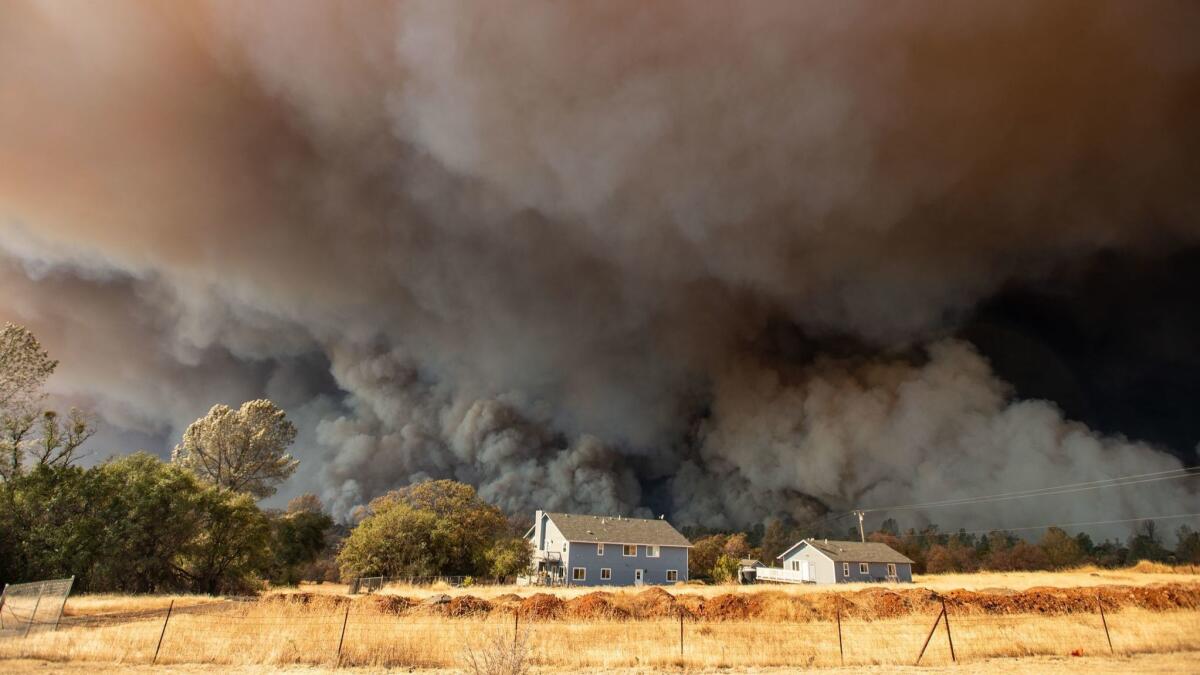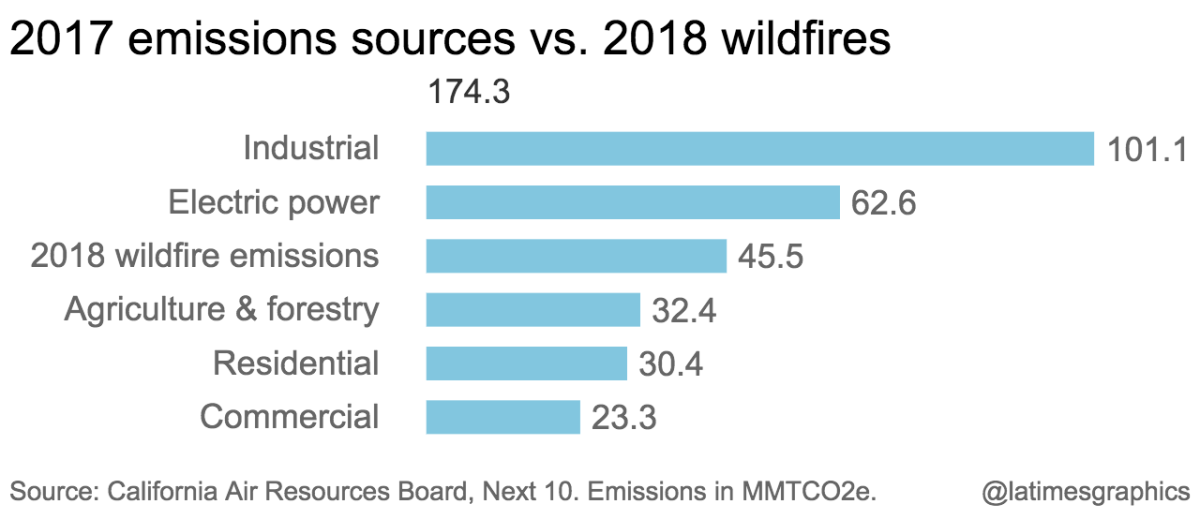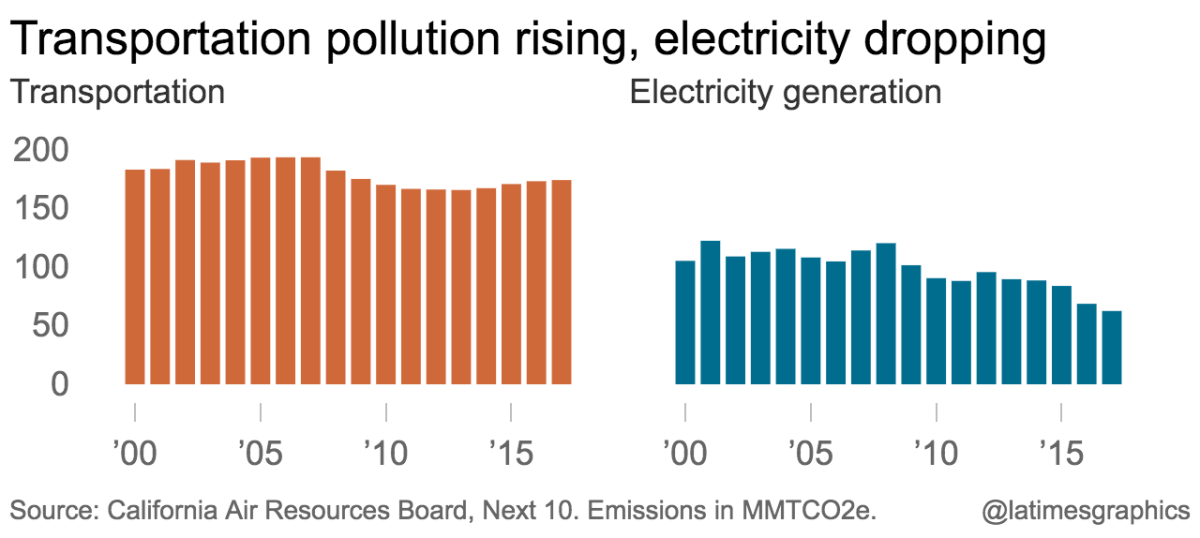Wildfires a massive threat to California’s progress in cutting greenhouse gases, report says

- Share via
The wildfires that raged last year from Paradise to Malibu made for California’s deadliest, most destructive fire season on record.
But the eruption of blazes marked another distinction for California, as one of the worst for the climate. In 2018, fires released more than 45 million metric tons of carbon dioxide into the atmosphere — the most in a decade and trailing only slightly behind 2008, when the state was also stricken by two of the largest wildfires in modern history.
Those state emissions estimates are highlighted in a report that a San Francisco organization released Tuesday that identifies rising pollution from wildfires, transportation and landfills as among the biggest obstacles standing between California and its ambitious climate goals.
The report, prepared by the independent consulting firm Beacon Economics for the Next 10 think tank, describes a vicious circle in which air pollution from fires, growing more intense and destructive with the warming climate, threatens to undermine the state’s progress in reducing greenhouse gas emissions.
Though California has successfully cut carbon pollution, meeting its 2020 target four years early, “these achievements were eclipsed several times over by the 2018 wildfires, which produced more than nine times more emissions than were reduced in 2017,” according to the report.
If wildfires were listed alongside other pollution sources tracked by the state, their 2018 emissions would rank among the largest, spewing more than the state’s commercial, residential or agricultural sectors in 2017 — the most recent year for which data is available — but less than transportation, industry or electricity generation.
“As the wildfire seasons grow longer and our lands grow drier, managing this threat will be critical to our climate success,” Next 10 founder F. Noel Perry wrote in the report.
State climate regulators said it was misleading to compare the carbon released by wildfires and the emissions from burning fossil fuels, which they said are two completely different types of pollution. The Air Resources Board tracks wildfire emissions in a separate inventory for ecosystems, soil and other sectors that are not regulated.
“The carbon stored in wildfires is part of the natural carbon cycle; emissions from fossil fuels are the result of pulling carbon out of the ground that otherwise would not be there, and pumping it into the atmosphere,” said Stanley Young, an Air Resources Board spokesman.
Young said the state is working on measures both to reduce the severity of wildfires and to ensure forests can store more carbon, “turning to a broad new set of forest management practices that will help with wildlands emissions.”
Adam Fowler, research director at Beacon Economics, agreed that wildfire emissions should be tracked separately from other greenhouse gases. But he said it’s an important comparison, showing that years of work to squeeze carbon from the state’s economy can be wiped out by one bad fire season.
Though wildfires would happen naturally, even without human influence, Fowler noted, “as these continue to get worse there is some percentage of that emissions total that we can hold ourselves accountable for.”
Huge blazes also threaten the role California’s forests play as carbon “sinks” that sequester planet-warming emissions from the atmosphere, according to the report, which suggests that with the recent increase in wildfires, in 2017 “the state’s forests may have acted as a net source for carbon emissions.”

The analysis, called the California Green Innovation Index, tracks key measures of environmental progress, relying heavily on the Air Resources Board’s annual inventory that shows emissions declining in recent years after peaking in 2004. But it paints a more sobering picture of the challenges the state faces, saying that California must dramatically increase its pollution-reduction efforts or risk falling behind.
The state’s most recent data show pollution reductions slowed to 1.2% in 2017 compared with 2.8% in 2016. If California sticks to its current pace, it will be decades late in meeting its ambitious goal of cutting greenhouse gases 40% below 1990 levels by 2030, according to the report.
To meet that goal on time, the state must increase those reductions more than threefold, to an average of 4.5% annually, the report found.
“We’re going to need major policy breakthroughs and deep structural changes if we’re going to deliver the much steeper emissions reductions required in the years ahead,” Perry said.
The state Air Resources Board pointed to a 2017 plan that “lays out a cost-effective, technologically feasible path” to the 2030 target, including measures to transform the state’s vehicle fleet, reduce the amount of driving and strengthen industry regulations.
“But it is a plan and we need to make sure the policies and necessary transformations identified in it are actually happening,” Young, the air board spokesman, said.

Michael Kleeman, a professor of civil and environmental engineering at UC Davis who was not involved in the report, said it is fair to compare wildfire emissions to regulated sectors to help put the numbers in perspective. “But I wouldn’t use that comparison to conclude that the state reduction efforts have no value.”
In contrast with the “fossil carbon” spewed by cars, trucks and power plants, the 2018 wildfires released “modern carbon” that will be reabsorbed and drawn back out of the atmosphere as burned areas regrow in the coming decades, Kleeman explained.
“The wildfires had many catastrophic effects and the release of carbon is definitely one of those bad outcomes,” Kleeman said. “But a significant fraction of that carbon should be drawn back into the regrowing forest over the long run. The wildfires definitely do not diminish the positive aspects of California’s other greenhouse gas mitigation efforts.”

Wildfires are not the state’s only obstacle.
Success in reducing carbon emissions from power generation has masked a lack of progress in cleaning up pollution from transportation, buildings and industry, according to the report.
The electricity sector was the only sector of California’s economy that has seen “continuous and significant improvement in reducing greenhouse gas emissions,” since 2000, the report stated.
Landfill emissions have risen each year since 2004 as Californians waste more and recycle less, according to the report, an increasing challenge with California and other states unable to send recyclables to China and other foreign markets.
Pollution from transportation, the state’s leading source of emissions, has been rising in recent years and remains the biggest obstacle to reaching the goal of carbon neutrality by mid-century.
California’s love affair with the car — and increasingly, trucks and SUVs — is partly to blame. Californians are driving more, and vehicle ownership rates are on the rise. Vehicle miles are increasing in California even as they decline in other big states, such as Pennsylvania and New York.
Young pointed to a recent executive order by Gov. Gavin Newsom, and the state’s allocation of hundreds of millions of dollars from its cap-and-trade program to the purchase of zero-emission cars and trucks, as “examples of California’s full-throated commitment to transforming the transportation sector.”
Though California is the world’s fifth-largest economy, it ranks as the 19th-biggest polluter globally, emitting more greenhouse gas emissions than France or Thailand but less than Australia, Mexico and the United Kingdom, according to the report.
“Every choice we make about how to use our land, power our buildings and travel makes a difference,” Fowler said. “We’re slowly changing an entire economy away from that fossil fuel backbone, and it takes a lot of people rowing in the same direction.”







